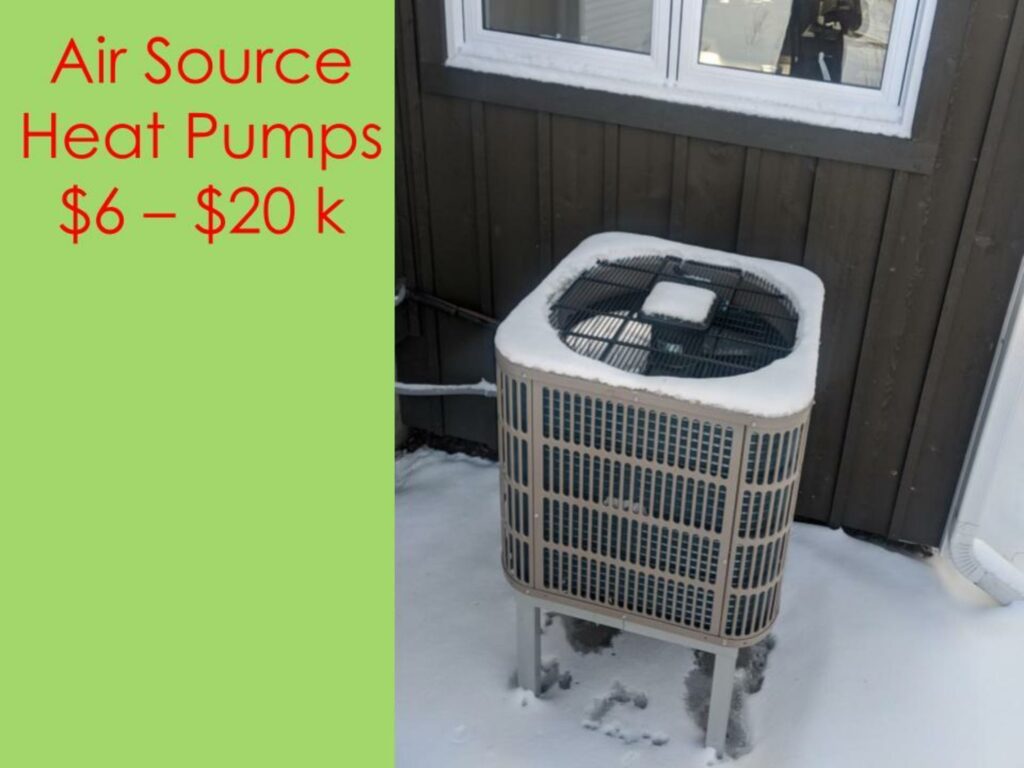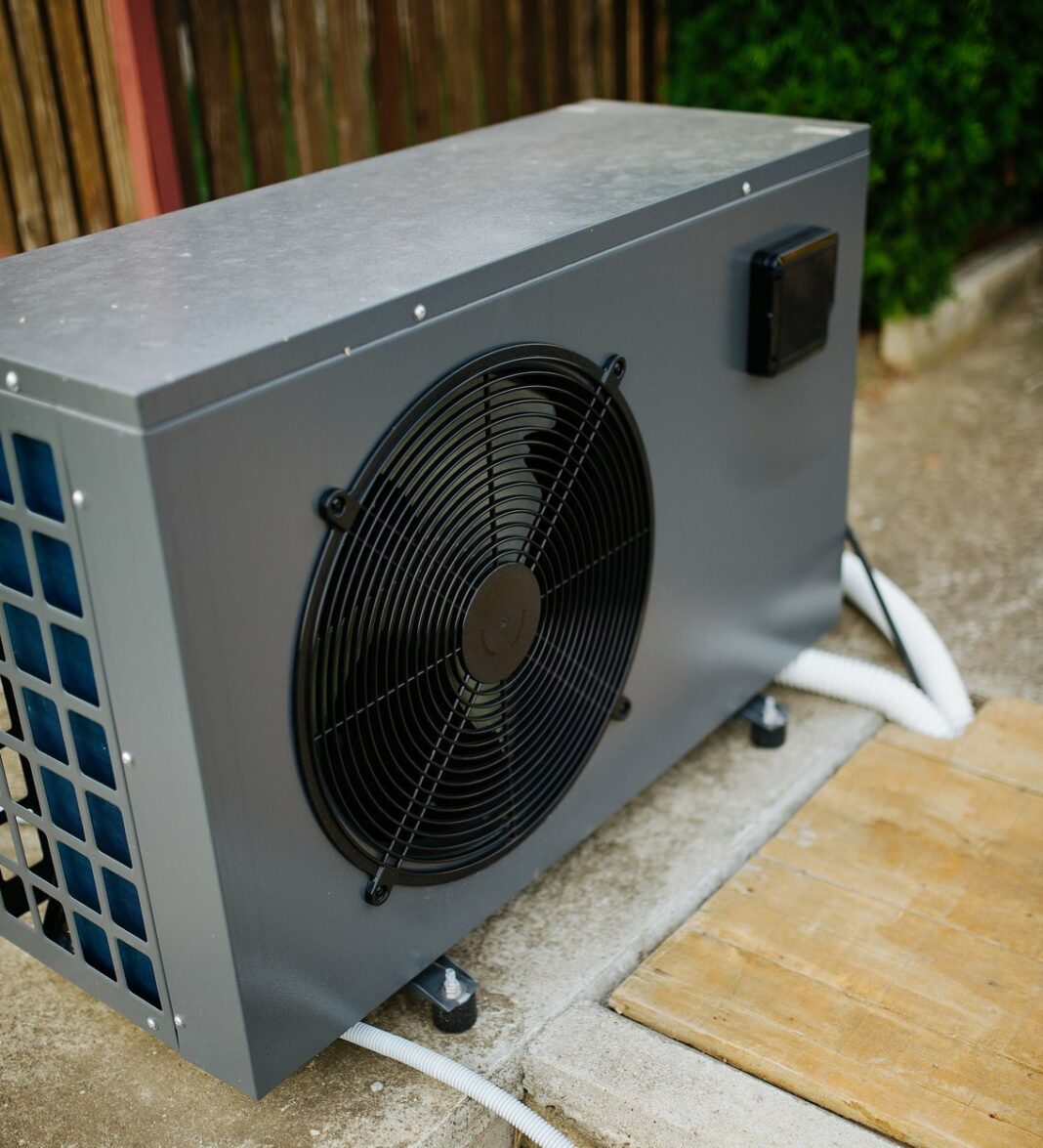Everybody’s pumped about heat pumps! But what are they, how do they work (especially in cold climates), and who will help me finance one?
Heating and cooling homes with oil, natural gas, and propane furnaces generates significant greenhouse gas emissions and contributes to climate change. As a result, governments around the world are encouraging homeowners whose fossil-fueled furnaces or boilers are at the end of their useful life to replace them with cleaner, more energy-efficient air-source electric heat pumps, and they often offer financial rebates to offset the cost of buying and installing them. But though plenty of us have heard about heat pumps, we might wonder why they’re touted as the future of home heating, and whether they’ll work for us. So let’s cut through the confusion.
What is a heat pump?
Today, most residential heat pump conversions involve an air-source heat pump (ASHP). Unlike a furnace that generates heat by burning fossil fuel, an ASHP moves heat from one place to another. An air conditioner is a heat pump that moves heat energy inside your home on a summer day to the hot air outside. A heat pump that heats your home in winter is an air conditioner working in reverse: it pulls heat from very cool or cold outdoor air (yes, there’s plenty of heat in cold air) into the home to keep the indoor temperature warm. Most heat pumps provide both air conditioning and heating.
“You just set the temperature you want, and the heat pump changes from one mode to the other,” says Steve Lapp, an engineer and former professor at the Energy Systems and Engineering Technology Program of St. Lawrence College in Kingston, Ontario.
What are the main components of a heat pump?
The specifics vary from model to model, but an air-source heat pump — the most popular type — will have a heat exchanger unit outside the house to absorb outside heat and another exchanger inside the house to expel it. These are the two largest components and are connected via a closed-loop copper pipe system filled with refrigerant. The other key components are the unit’s compressor and the expansion valves.
How does a heat pump work in winter?
Inside the outdoor heat exchanger, an electric fan blows cold outside ambient-temperature air over a twisty tube (the “evaporator coil”) containing the refrigerant that circulates throughout the system. The refrigerant enters the evaporator as an extremely cold gas. Since heat always wants to move from a warm place to a cooler place, heat from the outdoor air is absorbed by the much cooler refrigerant via the coil. The now-warmer vaporized refrigerant flows to the compressor, which pressurizes it, and — because the greater the pressure of a gas, the higher its temperature — the gas becomes hot enough to heat a home. This superheated gas flows to the interior heat exchanger (known as the condenser), where a fan blows the cooler room air over the coil to cool the gas. As it cools, the vapor transfers its heat to the coil, and the fan blows this same heat into the room to warm your house. As the heat is expelled to the house, the gas in the coil evaporator condenses, cools, and becomes a liquid. The liquid soon flows through an expansion valve that works like the nozzle on a spray bottle and causes the refrigerant to become a sort of liquid-vapor mix. This far cooler, lower-pressure mist/gas returns to the outside heat exchanger, where it once again absorbs heat from the cool outside air, and the whole process is repeated in what is known as the “refrigerant cycle.”

If the home has a forced air ducting system, electric fans blow warm air from the interior heat exchanger throughout the home via floor or wall vents. In another type of air-source heat pump, the hot refrigerant gas is piped to one or more rectangular “mini-split” units mounted on interior walls near the ceiling. The mini-splits blow warm air into the room.
Air-source heat pumps can also supply heat to liquid-based home heating systems such as hydronic floor heating. It’s harder to use ASHP to heat high-temperature hot-water radiator systems in older homes.
What kind of heat pumps are available?
The ASHP isn’t the only kind of heat pump out there. Some heat pumps capture heat energy in the ground or water. Known as “Ground Source Heat Pumps” (GSHP), they were the most common heat pump technology in North American homes until recently.
“Today, because of the cost-effectiveness and high efficiency of air-source heat pumps, they’ve mostly taken over the residential [heat pump] market,” Lapp says.
Why are heat pumps better than oil or gas furnaces?
There are two main reasons. The first is that heat pumps are far more energy-efficient than conventional furnaces or electric baseboard heaters. A typical oil or gas furnace is between 80% and 95% efficient – meaning that for every unit of energy used to run it, you’ll get slightly less than one unit of heat energy out of it. Electric baseboard heaters are 100% efficient. One kilowatt-hour of electrical energy put into the electric resistance heater is converted to one kilowatt-hour of heat energy. That 100% efficiency sounds good — but, in contrast, when you put one unit of electrical energy into a typical heat pump, you’ll get two to five units of heat energy out of it. It sounds hard to believe, but the energy efficiency of heat pumps really is from 200% to 500%.
The air-source heat pumps of twenty years ago were unsuitable for the colder temperatures found in the heating zones proximate to the US-Canada border, but the technology has improved dramatically since then.
The second reason is that heat pumps use electricity, not fossil fuels, so they don’t directly emit greenhouse gases. Heat pumps are most climate-friendly when they’re powered by electricity derived from low-carbon electricity sources such as wind, solar, hydro, or nuclear.
Do heat pumps work in very cold temperatures?
Many air-source heat pumps of twenty years ago were unsuitable for the colder temperatures found in the heating zones near the US-Canada border, but the technology has improved dramatically since then. Today, a conventional ASHP can easily warm a home when outdoor temperatures hover around the freezing point (32°F/0°C). A cold-climate heat pump can maintain significant heating capacity to temperatures as low as -13°F/-25°C. In temperatures lower than that, these heat pumps rapidly lose efficiency, so HVAC contractors will advise you to also have a backup heat source such as an electric furnace. A knowledgeable HVAC contractor can determine exactly what combination of air-source heat pump and (if necessary) backup heating system is best for your home. The final design and components required will depend on the climate zone you live in, your home’s heating requirements, how well-insulated your home is, and the capacity of its electrical system.
How much do heat pumps cost?
The main downside to heat pumps is that they’re expensive. The cost of purchasing and installing a home heat pump will vary dramatically according to the type of system, whether or not it includes a backup heat source, and the heating (and cooling) capacity of the system. A two-way ASHP ( which provides both heating and air conditioning) in a well-insulated 2,000-square-foot suburban bungalow will likely have a total installation cost of $8,000 to $20,000. Get a quote from a reliable contractor who can properly assess the requirements.
Although the up-front cost can be discouraging, when compared to oil, propane, or electric resistance heating equipment, the annual cost of a heat pump can be fifty to seventy percent less than that of a fossil-fuel-based system. Depending on the size of your previous fossil fuel heating bill, this will be a savings of hundreds if not thousands of dollars per year. Think, for instance, of a $3,000 annual propane heating bill versus a $1,000 bill to operate an ASHP.

An ASHP running on low-carbon electricity also provides a large reduction in greenhouse gas emissions compared to a natural gas or oil furnace. If you need a new natural gas furnace and AC unit, a conversion to a heat pump is worth considering. However, switching out a perfectly good natural gas furnace is not generally financially attractive due to the relatively low current natural gas pricing. Some people are switching to reap the climate change benefits, but it’s not financially viable for everyone.
Lapp, however, notes that “to address climate change, it’s generally accepted that all of our natural gas furnaces will have to be converted to heat pump technology by 2050.”
What kind of heat pump rebates are available?
Many governments are offering rebates and incentives such as tax credits to reduce the cost of installing heat pumps. In the US, for example, the Energy Efficient Home Improvement Credit provides a tax incentive to people who spend money to improve their home’s energy efficiency. The Weatherization Assistance Program offers weatherization assistance and upgrades to low-income homeowners, which reduces their energy bills while also reducing greenhouse emissions. In Canada, the Greener Homes program provides eligible homeowners with rebates of up to $5,000 for heat pump installations and other home energy-efficiency retrofits, such as insulation upgrades. Most states and provinces also offer their own heat pump incentives that often can be combined with the federal ones. To find them, do an online search or ask a local HVAC contractor what programs are available in your area.
What You Can Do
Check out Rewiring America’s online calculator to determine what you’re eligible for in rebates and incentives from the federal Inflation Reduction Act.


